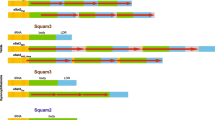Abstract
Subterminal satellite (StSat) repeats, consisting of 32-bp-long AT-rich units (GATATTTCCATGTT(T/C)ATACAGATAGCGGTGTA), were first found in chimpanzee and gorilla (African great apes) as one of the major components of heterochromatic regions located proximal to telomeres of chromosomes. StSat repeats have not been found in orangutan (Asian great ape) or human. This patchy distribution among species suggested that the StSat repeats were present in the common ancestor of African great apes and subsequently lost in the lineage leading to human. An alternative explanation is that the StSat repeats in chimpanzee and gorilla have different origins and the repeats did not occur in human. The purpose of the present study was quantitative evaluation of the above alternative possibilities by analyzing the nucleotide variation contained in the repeats. We collected large numbers of sequences of repeat units from genome sequence databases of chimpanzee and gorilla, and also bonobo (an African great ape phylogenetically closer to chimpanzee). We then compared the base composition of the repeat units among the 3 species, and found statistically significant similarities in the base composition. These results support the view that the StSat repeats had already formed multiple arrays in the common ancestor of African great apes. It is thus suggested that humans lost StSat repeats which had once grown to multiple arrays.






Similar content being viewed by others
References
Glazko GV, Nei M (2003) Estimation of divergence times for major lineages of primate species. Mol Biol Evol 20:424–434
Haaf T, Schmid M (1987) Chromosome heteromorphisms in the gorilla karyotype. Analyses with distamycin A/DAPI, quinacrine and 5-azacytidine. J Hered 78:287–292
Hirai H (2001) Relationship of telomere sequence and constitutive heterochromatin in the human and apes as detected by PRINS. Methods Cell Sci 23:29–35
Hirai H, Taguchi T, Godwin AK (1999) Genomic differentiation of 18S ribosomal DNA and beta-satellite DNA in the hominoid and its evolutionary aspects. Chrom Res 7:531–540
Hirai H, Hirai Y, Kawamoto Y, Endo H, Kimura J, Rerkamnuaychoke W (2002) Cytogenetic differentiation of two synpatric tree shrew taxa found in the southern part of the Isthmus of Kra. Chrom Res 10:313–327
Hirai H, Matsubayashi K, Kumazaki K, Kato A, Maeda N, Kim HS (2005) Chimpanzee chromosomes: retrotransposable compound repeat DNA organization (RCRO) and its influence on meiotic prophase and crossing-over. Cytogenet Genome Res 108:248–254
Koga A, Hori H, Ishikawa Y (2002) Gamera, a family of LINE-like repetitive sequences widely distributed in medaka and related fishes. Heredity 8:446–452
Marks J (1985) C-band variability in the common chimpanzee, Pan troglodytes. J Hum Evol 14:669–675
Royle NJ, Baird DM, Jeffreys AJ (1994) A subterminal satellite located adjacent to telomeres in chimpanzees is absent from the human genome. Nat Genet 6:52–56
Stanyon R, Chiarelli B, Gottlieb K, Patton W (1986) The phylogenetic and taxonomic status of Pan paniscus: a chromosomal perspective. Am J Phys Antholopol 69:489–498
Won YJ, Hey J (2005) Divergence population genetics of chimpanzees. Mol Biol Evol 22:297–307
Acknowledgments
We are grateful to Drs. Elizabeth Nakajima, Takashi Kageyama and Takafumi Tezuka for helpful discussions. Epithelial tissue of gorilla was obtained through the Great Ape Information Network (GAIN) project. This research was supported by the Global COE Program of MEXT of Japan (A06 to Kyoto University) and grants from the Japan Society for the Promotion of Science (20405016 and 22247037 to HH).
Author information
Authors and Affiliations
Corresponding author
Rights and permissions
About this article
Cite this article
Koga, A., Notohara, M. & Hirai, H. Evolution of subterminal satellite (StSat) repeats in hominids. Genetica 139, 167–175 (2011). https://doi.org/10.1007/s10709-010-9534-0
Received:
Accepted:
Published:
Issue Date:
DOI: https://doi.org/10.1007/s10709-010-9534-0




